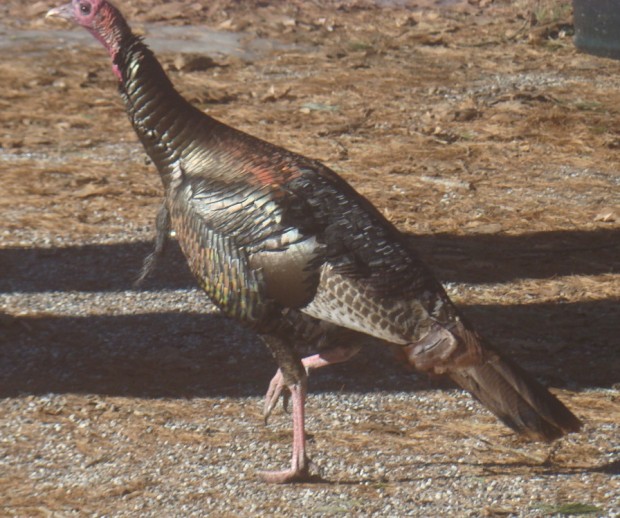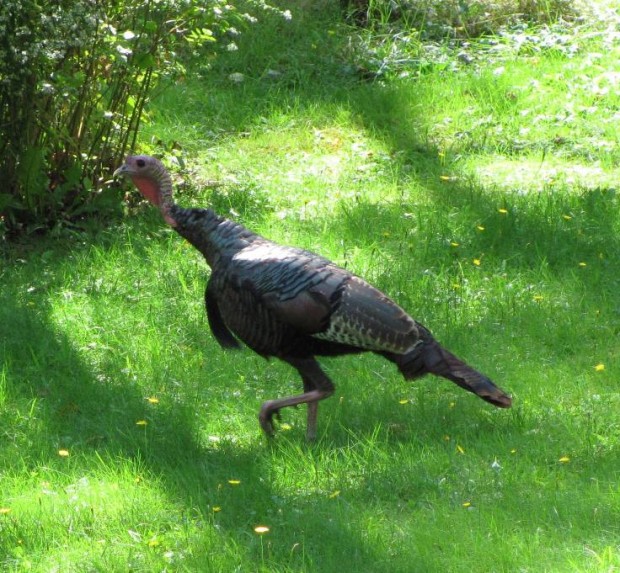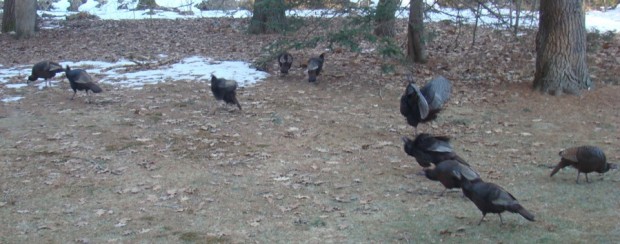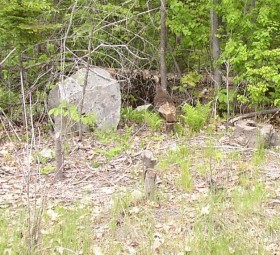From an article by George Matula
Wildlife Biologist, Department of Inland Fisheries and Wildlife
Physical Characteristics
 The Wild Turkey is North America’s largest upland game bird. Average adult hens weigh between 8 – 12 lb. and adult toms (males) between 10 – 20 lb., but a large tom can weigh in excess of 25 lb. Toms sport beards which are bristle-like feathers that protrude from the chest and can grow to a length of more than 12 inches on older toms. Beards may be present on about 10% of the hens; however, they are thinner and shorter than those of adult males.
The Wild Turkey is North America’s largest upland game bird. Average adult hens weigh between 8 – 12 lb. and adult toms (males) between 10 – 20 lb., but a large tom can weigh in excess of 25 lb. Toms sport beards which are bristle-like feathers that protrude from the chest and can grow to a length of more than 12 inches on older toms. Beards may be present on about 10% of the hens; however, they are thinner and shorter than those of adult males.
Heads of gobblers (adult toms) are generally bare and blue with a hint of pink and red, but colors can change with the mood of the tom. During mating season, the gobbler’s crown swells and turns white and its wattles become large and bright red. Heads of hens are somewhat feathered with smaller, darker feathers extending up from the back of the neck. Legs of toms are longer than the hens and are equipped with spurs.
Footprints of toms can exceed 6 inches, whereas hen’s footprints rarely exceed 4+ inches. The breast feathers of hens are buff or brown tipped; the tom’s are tipped with a sharp band of black. Wild Turkey’s plumage is more iridescent than domestic turkeys, and their tail feathers are tipped with brown rather than the white found on tame birds. Wild Turkeys have keen eyesight, acute hearing, and are agile fliers, although they often walk or run from danger.
Natural History
Habitat. Eastern Wild Turkeys generally require large tracts of mature hardwoods (especially nut producing species such as oak and beech) interspersed with stands of mature pine. They also require grassy openings and hay and pasture lands for raising their young. Turkeys blend into their habitats to avoid predators.
Food habits. Turkeys feed on a wide variety of animal and plant materials such as insects, greens, fruits, berries, seeds, grains, and nuts. During winter, turkeys feed on bayberry fruits, sensitive fern spore heads, burdock seeds and other vegetation around spring-fed brooks and on bare edges of fields. In Maine, turkeys also depend on dairy farms for food to survive winter. Dairy farms provide silage corn and manure containing undigested corn that is either spread on fields or stockpiled for future spreading.
Reproduction. Wild Turkeys in Maine breed during April and May. Dominant toms do most of the breeding. Through elaborate strutting and gobbling, they try to attract and mate with as many hens as they can, which may be as many as 12 or more.
After breeding, hens confine themselves to nesting. They construct nests in shallow depressions on the ground at the base of a tree or stump, under a tangle of brush, or in dense herbaceous cover. One egg is laid each day for up to ten to twelve days. Eggs are incubated by the hen from 26 to 28 days before hatching. If left unguarded, eggs are vulnerable to predators such as crows, skunks, raccoons, and red squirrels, and incubating hens can fall prey to dogs, coyotes, foxes, raccoons, bobcats, fisher, and great horned owls.
 Poults (young turkeys) usually leave the nest the day they are hatched. Hens and their broods frequent field edges and forest openings in search of insects, which provide protein poults need for rapid growth during their early development. After 5-6 weeks of age, young turkeys begin roosting in trees, thus greatly reducing their vulnerability to predators.
Poults (young turkeys) usually leave the nest the day they are hatched. Hens and their broods frequent field edges and forest openings in search of insects, which provide protein poults need for rapid growth during their early development. After 5-6 weeks of age, young turkeys begin roosting in trees, thus greatly reducing their vulnerability to predators.
Longevity. Mortality is greatest and most variable in the early stages of life. Once Wild Turkeys reach adulthood, they may live as long as 10 years.
Movements. Hens and their poults join other poults and hens to form flocks of 6 – 25 birds (occasionally up to 50 birds) during late summer, fall, and winter. Adult toms generally remain loners, but small groups of 2 to 5 toms of mixed ages are commonly seen throughout the year except breeding season. Feeding turkeys can cover several miles in a day.
Historical Management in Maine
Population and distribution trends. Historically, wild turkeys existed in significant numbers in York and Cumberland Counties, and perhaps in lower numbers eastward to Hancock County. From the time of settlement until 1880, agricultural practices intensified until farmland comprised about 90% of York and Cumberland counties.
The reduction in forest land and unrestricted hunting are believed to be the two most important factors leading to the extirpation of native wild turkeys in Maine in the early 1800s. Since 1880, many farms have been abandoned and the land has reverted back to forest. By 1970, only 15% of York and Cumberland Counties remained farmland. This reversion of thousands of acres of farmland to wooded habitat greatly enhanced prospects for reestablishing turkeys into their former range. Attempts to reintroduce turkeys to Maine began in 1942 when the Department of Inland Fisheries and Game released 24 birds on Swan Island, in Sagadahoc County. In the 1960s, fish and game clubs in Bangor and Windham made similar attempts to reestablish turkey in their areas using imported birds raised from part wild and part game-farm stocks. None of these attempts succeeded in establishing populations of wild birds.
 In 1977 and 1978, the Maine Department of Inland Fisheries and Wildlife obtained 41 Wild Turkeys from Vermont and released them in the towns of York and Eliot. In Spring 1982, 33 turkeys were trapped from the growing York County population and released in Waldo County. In the winter of 1984, 19 birds were captured in York County and released in Hancock County, but poaching was believed to be the demise of these birds. During the winters of 1987 and 1988, 70 Wild Turkeys were obtained from Connecticut to augment Maine’s growing turkey population. Snow depth is believed to be the major factor limiting the distribution of turkeys in Maine.
In 1977 and 1978, the Maine Department of Inland Fisheries and Wildlife obtained 41 Wild Turkeys from Vermont and released them in the towns of York and Eliot. In Spring 1982, 33 turkeys were trapped from the growing York County population and released in Waldo County. In the winter of 1984, 19 birds were captured in York County and released in Hancock County, but poaching was believed to be the demise of these birds. During the winters of 1987 and 1988, 70 Wild Turkeys were obtained from Connecticut to augment Maine’s growing turkey population. Snow depth is believed to be the major factor limiting the distribution of turkeys in Maine.
| Year | Applicants | Permits | Turkeys |
| 1986 | 605 | 500 | 9 |
| 1987 | 536 | 500 | 8 |
| 1988 | 355 | 355 | 16 |
| 1989 | 464 | 463 | 19 |
| 1990 | 500 | 499 | 15 |
| 1991 | 508 | 500 | 21 |
| 1992 | 886 | 500 | 53 |
| 1993 | 1,079 | 500 | 46 |
| 1994 | 1,185 | 500 | 62 |
| 1995 | 1,712 | 750 | 117 |
| 1996 | 3,952 | 1,250 | 288 |
| 1997 | 5,091 | 1,750 | 417 |
| 1998 | 6,449 | 2,250 | 594 |
| 1999 | 9,294 | 3,000 | 890 |
| 2000 | 14,909 | 4,000 | 1,559 |
| 2001 | 18,685 | 7,000 | 2,544 |
| 2002 | 25,954 | 9,000 | 3,391 |
| 2003 | 26,505 | 12,000 | 3,994 |
| 2004 | 24,040 |
15,600 | 4,839 |
| 2005 | 23,951 | 23,951 | 6,236 |
| 2006 | NA | 19,393 | 5,931 |
| 2007 | NA | 18,383 | 5,984 |
| 2008 | NA | 16,525 | 6,348 |
| 2009 | NA | 16,859 | 6,043 |
Prior to 2005, applicants for permits were entered n a lottery to choose those who would receive permit. Since then, all applicants for permits receive them.
Additional resources
Huebner, Janice A. Wild Turkey Foraging Behavior and Crop Depredation on Wild Blueberry Farms in Maine. 2010. (Thesis (M.S.) in Ecology and Environmental Science–University of Maine, 2010.)
Maine. Dept. of Inland Fisheries and Wildlife. “A Report to the Joint Standing Committee on Inland Fisheries and Wildlife . . . .” submitted by Roland D. Martin, Commissioner. Augusta, Me. The Department. 2010.
Treiterer, Beatrix Elisabeth. Reproductive Ecology and Habitat Use of Female Wild Turkeys in Waldo County, Maine. 1987. (Thesis (M.S.) in Wildlife Management–University of Maine, 1987.)
Wildlife Division Research & Management Report. Various Years. Augusta. Maine Department of Inland Fisheries and Wildlife. http://www.mefishwildlife.com



